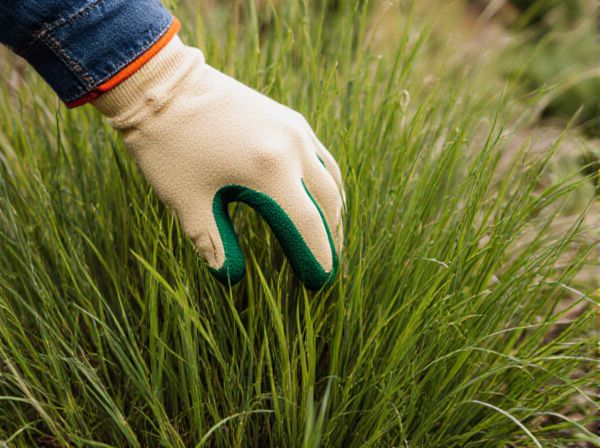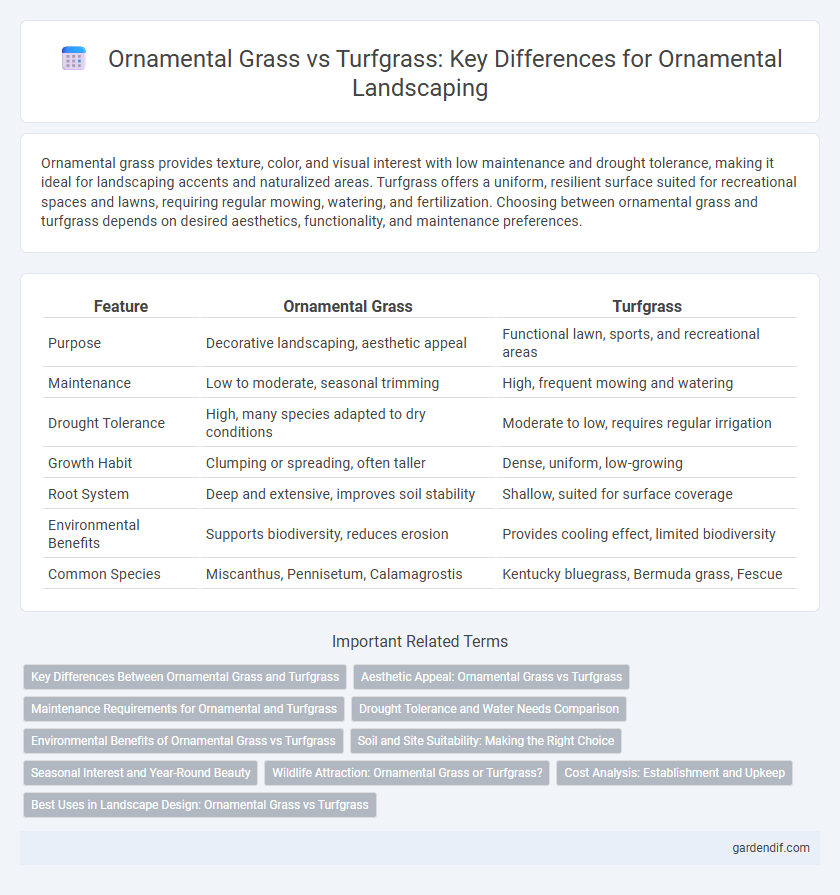
ornamental grass vs turfgrass Illustration
Ornamental grass provides texture, color, and visual interest with low maintenance and drought tolerance, making it ideal for landscaping accents and naturalized areas. Turfgrass offers a uniform, resilient surface suited for recreational spaces and lawns, requiring regular mowing, watering, and fertilization. Choosing between ornamental grass and turfgrass depends on desired aesthetics, functionality, and maintenance preferences.
Table of Comparison
| Feature | Ornamental Grass | Turfgrass |
|---|---|---|
| Purpose | Decorative landscaping, aesthetic appeal | Functional lawn, sports, and recreational areas |
| Maintenance | Low to moderate, seasonal trimming | High, frequent mowing and watering |
| Drought Tolerance | High, many species adapted to dry conditions | Moderate to low, requires regular irrigation |
| Growth Habit | Clumping or spreading, often taller | Dense, uniform, low-growing |
| Root System | Deep and extensive, improves soil stability | Shallow, suited for surface coverage |
| Environmental Benefits | Supports biodiversity, reduces erosion | Provides cooling effect, limited biodiversity |
| Common Species | Miscanthus, Pennisetum, Calamagrostis | Kentucky bluegrass, Bermuda grass, Fescue |
Key Differences Between Ornamental Grass and Turfgrass
Ornamental grass features varied textures, colors, and heights designed for aesthetic appeal and landscape accentuation, while turfgrass is cultivated for uniformity, durability, and functionality in lawns and sports fields. Key differences include growth patterns, maintenance requirements, and environmental adaptability, with ornamental grass often requiring less mowing and thriving in diverse soil conditions compared to the dense, wear-resistant turfgrass. The ecological benefits of ornamental grass, such as enhanced biodiversity and drought tolerance, contrast with turfgrass's emphasis on providing a resilient, low-height ground cover.
Aesthetic Appeal: Ornamental Grass vs Turfgrass
Ornamental grasses offer diverse textures, colors, and heights that create dynamic landscapes, enhancing visual interest beyond the uniform appearance of turfgrass. Their natural movement and seasonal changes contribute to a more vibrant and attractive garden setting. Turfgrass provides a consistent, lush green carpet ideal for recreational spaces but lacks the architectural and textural complexity that ornamental grasses bring.
Maintenance Requirements for Ornamental and Turfgrass
Ornamental grasses require less frequent mowing and typically need minimal fertilization compared to turfgrass, making them ideal for low-maintenance landscapes. Turfgrass demands regular watering, frequent mowing, and periodic aeration to maintain a lush, uniform appearance. Choosing between ornamental and turfgrass hinges on balancing aesthetic preferences with the time and resources available for ongoing maintenance.
Drought Tolerance and Water Needs Comparison
Ornamental grasses demonstrate superior drought tolerance compared to traditional turfgrass, often thriving with significantly less water due to deep root systems that access moisture efficiently. Turfgrass typically requires frequent irrigation to maintain its lush green appearance, making it less suitable for water-conservation landscapes. Choosing drought-resistant ornamental grasses reduces water usage by up to 50%, enhancing sustainability in arid and semi-arid environments.
Environmental Benefits of Ornamental Grass vs Turfgrass
Ornamental grasses offer significant environmental benefits compared to traditional turfgrass, including lower water consumption due to deep root systems that enhance soil moisture retention. These grasses support biodiversity by providing habitats for pollinators and other beneficial insects, while turfgrass often requires extensive chemical fertilizers and pesticides that can harm ecosystems. Furthermore, ornamental grasses improve soil health and reduce erosion, contributing to sustainable landscaping practices and carbon sequestration.
Soil and Site Suitability: Making the Right Choice
Ornamental grasses thrive in a wide range of soil types, including poor and well-drained soils, making them ideal for sites with challenging conditions where turfgrass might struggle. Turfgrass generally requires fertile, well-aerated soil with consistent moisture to maintain its lush appearance and durability. Understanding the specific soil texture, pH, drainage, and sunlight exposure of your site ensures the best selection between ornamental grass and turfgrass for long-term landscape success.
Seasonal Interest and Year-Round Beauty
Ornamental grasses provide dynamic seasonal interest through vibrant color changes, textures, and movement that evolve from spring through winter, enhancing garden aesthetics year-round. Turfgrass, while offering a consistent green backdrop, tends to lack the visual diversity and seasonal transformation found in ornamental varieties. Choosing ornamental grasses boosts year-round beauty by combining resilience with striking foliage that adapts to varying climates and seasons.
Wildlife Attraction: Ornamental Grass or Turfgrass?
Ornamental grasses provide superior wildlife habitat compared to turfgrass by offering shelter, nesting sites, and food sources for birds, insects, and small mammals. Native varieties of ornamental grass enhance biodiversity and support pollinators, whereas turfgrass typically lacks these ecological benefits. The structural diversity and seed production of ornamental grasses make them a preferred choice for promoting local wildlife attraction.
Cost Analysis: Establishment and Upkeep
Ornamental grass typically demands lower establishment costs than turfgrass due to minimal soil preparation and less frequent reseeding. Maintenance expenses for ornamental grass are reduced by its drought tolerance and infrequent mowing requirements, contrasting with the intensive irrigation, fertilization, and mowing schedules required to maintain healthy turfgrass. Overall, the cost analysis favors ornamental grass in regions aiming for sustainable landscaping with budget-conscious upkeep.
Best Uses in Landscape Design: Ornamental Grass vs Turfgrass
Ornamental grass excels in landscape design for adding texture, height variation, and seasonal interest, making it ideal for accent planting, borders, and naturalistic gardens. Turfgrass provides a uniform, resilient ground cover suited for recreational areas, pathways, and formal lawns requiring low maintenance and durability. Integrating ornamental grass with turfgrass balances aesthetic appeal and functionality, enhancing both visual diversity and usability in outdoor spaces.
ornamental grass vs turfgrass Infographic

 gardendif.com
gardendif.com